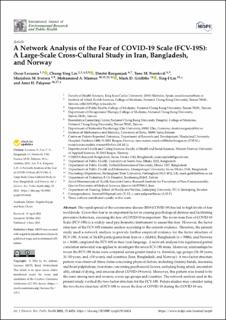A Network Analysis of the Fear of COVID-19 Scale (FCV-19S): A Large-Scale Cross-Cultural Study in Iran, Bangladesh, and Norway
| dc.contributor.author | Lecuona, Oscar | |
| dc.contributor.author | Lin, Chung-Ying | |
| dc.contributor.author | Rozgonjuk, Dmitri | |
| dc.contributor.author | Norekvål, Tone Merete | |
| dc.contributor.author | Iversen, Marjolein M. | |
| dc.contributor.author | Mamun, Mohammed A. | |
| dc.contributor.author | Griffiths, Mark D. | |
| dc.contributor.author | Lin, Ting-I | |
| dc.contributor.author | Pakpour, Amir H. | |
| dc.date.accessioned | 2023-03-01T12:44:35Z | |
| dc.date.available | 2023-03-01T12:44:35Z | |
| dc.date.created | 2022-09-06T18:03:46Z | |
| dc.date.issued | 2022 | |
| dc.identifier.citation | International Journal of Environmental Research and Public Health (IJERPH). 2022, 19 (11):6824. | en_US |
| dc.identifier.issn | 1661-7827 | |
| dc.identifier.uri | https://hdl.handle.net/11250/3054999 | |
| dc.description.abstract | The rapid spread of the coronavirus disease 2019 (COVID-19) has led to high levels of fear worldwide. Given that fear is an important factor in causing psychological distress and facilitating preventive behaviors, assessing the fear of COVID-19 is important. The seven-item Fear of COVID-19 Scale (FCV-19S) is a widely used psychometric instrument to assess this fear. However, the factor structure of the FCV-19S remains unclear according to the current evidence. Therefore, the present study used a network analysis to provide further empirical evidence for the factor structure of FCV-19S. A total of 24,429 participants from Iran (n = 10,843), Bangladesh (n = 9906), and Norway (n = 3680) completed the FCV-19S in their local language. A network analysis (via regularized partial correlation networks) was applied to investigate the seven FCV-19S items. Moreover, relationships between the FCV-19S items were compared across gender (males vs. females), age groups (18–30 years, 31–50 years, and >50 years), and countries (Iran, Bangladesh, and Norway). A two-factor structure pattern was observed (three items concerning physical factors, including clammy hands, insomnia, and heart palpitations; four items concerning psychosocial factors, including being afraid, uncomfortable, afraid of dying, and anxious about COVID-19 news). Moreover, this pattern was found to be the same among men and women, across age groups and countries. The network analysis used in the present study verified the two-factor structure for the FCV-19S. Future studies may consider using the two-factor structure of FCV-19S to assess the fear of COVID-19 during the COVID-19 era. | en_US |
| dc.language.iso | eng | en_US |
| dc.publisher | MDPI | en_US |
| dc.rights | Navngivelse 4.0 Internasjonal | * |
| dc.rights.uri | http://creativecommons.org/licenses/by/4.0/deed.no | * |
| dc.title | A Network Analysis of the Fear of COVID-19 Scale (FCV-19S): A Large-Scale Cross-Cultural Study in Iran, Bangladesh, and Norway | en_US |
| dc.type | Peer reviewed | en_US |
| dc.type | Journal article | en_US |
| dc.description.version | publishedVersion | en_US |
| dc.rights.holder | © 2022 by the authors. | en_US |
| dc.source.volume | 19 | en_US |
| dc.source.journal | International Journal of Environmental Research and Public Health (IJERPH) | en_US |
| dc.source.issue | 11 | en_US |
| dc.identifier.doi | 10.3390/ijerph19116824 | |
| dc.identifier.cristin | 2049282 | |
| dc.source.articlenumber | 6824 | en_US |
| cristin.ispublished | true | |
| cristin.fulltext | original | |
| cristin.qualitycode | 1 |
Tilhørende fil(er)
Denne innførselen finnes i følgende samling(er)
-
Import fra CRIStin [3604]
-
Institutt for helse- og omsorgsvitskap [2776]

